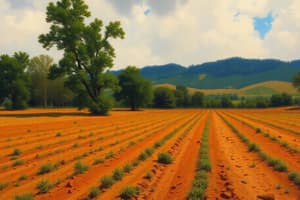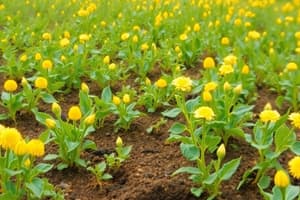Podcast
Questions and Answers
What is soil texture?
What is soil texture?
The proportion of soil particles, including sand, silt, and clay.
Which of the following is NOT a type of soil separate?
Which of the following is NOT a type of soil separate?
- Silt
- Sand
- Clay
- Gravel (correct)
Soil composition significantly affects soil properties and usability.
Soil composition significantly affects soil properties and usability.
True (A)
What are the two important features affected by soil particle size?
What are the two important features affected by soil particle size?
What is the largest size of soil separate?
What is the largest size of soil separate?
What influences soil permeability?
What influences soil permeability?
The measure of soil volume that holds air and water is called ______.
The measure of soil volume that holds air and water is called ______.
Match the soil structure types with their descriptions:
Match the soil structure types with their descriptions:
What is soil tilth?
What is soil tilth?
Working wet soil is recommended for good tilth.
Working wet soil is recommended for good tilth.
Which condition can reduce water infiltration and soil aeration?
Which condition can reduce water infiltration and soil aeration?
What does the Munsell color system help to classify?
What does the Munsell color system help to classify?
Soil particles cementing together can create a ______.
Soil particles cementing together can create a ______.
Flashcards are hidden until you start studying
Study Notes
Physical Properties of Soil
- Soil characteristics can be seen or felt, and are not chemical or biological, but both aspects influence them.
- Physical properties affect how soils are used for plant growth and other activities.
Soil Texture
- Soil texture affects important soil traits, such as water-holding capacity and aeration.
- It is determined by the proportion of different soil particles: sand (large), silt (medium), and clay (small).
Effects of Particle Size
- Specific surface area is the total surface area of all soil particles in a volume of soil.
- Greater surface area leads to increased:
- nutrient reactions on particle surfaces
- water-holding capacity, as water forms films around particles.
- Soil pores are spaces within the soil, categorized as either macropores (large) or micropores (small).
- Macropores are important for aeration, as they allow for air flow.
- Micropores primarily hold water, but can limit oxygen availability.
Soil Separates
- Sand is the largest soil separate, consisting primarily of weathered quartz or other minerals. It improves water infiltration and aeration, but can lead to lower water retention and nutrient levels.
- Silt is the medium-sized separate, known for its ability to hold a large amount of water available to plants. It is also susceptible to erosion by wind and water.
- Clay is the smallest soil separate, composed of tiny sheet-like crystals. It is formed through chemical reactions between weathered minerals.
Textural Classification
- The USDA System classifies soil separates into three broad classes: sand, silt, and clay.
- The percentage of each soil separate determines the soil texture, with 12 distinct textural classes.
- Soil texture can be determined through mechanical analysis, which measures the amount of sand, silt, and clay.
Soil Density & Permeability
- Particle density (PD) is the density of soil without pores.
- Bulk density (BD) accounts for pore space and is an indicator of soil quality. A lower BD generally indicates better soil quality.
- Porosity measures the volume of the soil that holds air and water.
Soil Structure
- Soil structure refers to how soil clumps together to form aggregates known as peds.
- Peds vary in size and shape, contributing to air and water flow within the soil.
- Structure improves soil fertility and enhances its functions.
- Soil structure can be classified by grade (ped distinctiveness and strength), class (ped size), and type (ped shape).
- A soil lacking structure is considered structureless, and often has poor permeability.
Types of Soil Structures
- Granular structure is common in A horizons.
- Platy structure is characteristic of E horizons.
- Blocky structure is typical of B horizons.
- Prismatic structures are found in lower B and C horizons.
Formation of Soil Structure
- Soil structure formation is a two-step process:
- Formation of a loose ped
- Cementing of the ped, typically by calcium ions that bridge soil particles (flocculation).
Soil Consistence
- Soil Consistence describes the behavior of soil when pressure is applied, and is influenced by moisture levels.
- Wet soil properties include stickiness and plasticity.
- Moist soil properties include looseness, friability, and firmness.
- Dry soil properties are assessed by crushing an air-dried mass of soil.
Soil Tilth
- Soil tilth refers to the physical condition of tilled soil, and indicates its ease of tillage, seedbed formation, seedling emergence, and root growth.
- It is a combination of texture, structure, permeability, and consistence.
- Tillage can improve tilth; however, it can also have negative impacts.
Injuries to Soil Tilth: Compaction
- Compaction occurs when pressure is applied to the soil surface, resulting in:
- Reduced porosity and permeability
- Decreased air exchange and potassium uptake
- Increased erosion and nitrous oxide evolution
- Reduced percolation and oxygen availability
Injuries to Soil Tilth: Aggregation Destruction
- Tillage can destroy soil aggregates by:
- Increasing organic matter oxidation, which weakens peds.
- Crushing non-weakened peds.
Injuries to Soil Tilth: Puddling & Clods
- Working wet soil, especially clay-rich soils, can lead to puddling, which is the conversion of aggregates into a massive soil mass.
- Puddling reduces water movement within the soil.
Injuries to Soil Tilth: Surface Crusts
- Raindrops hitting bare soil can destroy aggregates and create a hardened crust.
- This reduces water infiltration, air penetration, and seed emergence.
Improving Tilth
- Most effective methods focus on improving soil structure and avoiding compaction.
Soil Channels & Pans
- Channels are large, continuous pores extending from the surface to deeper soil layers.
- Biopores are channels created by soil organisms.
- Pans are hardened layers of soil, categorized by their composition and formation.
Soil Temperature
- Soil temperature is critical for plant growth and development.
- Factors influencing soil temperature include:
- Sunlight and air energy inputs
- Absorption and conductance of heat
- Heat loss at the surface.
Managing Soil Temperature
- Soil temperature can be managed through:
- Watering, which can cool the soil.
- Plowing in the fall, which raises spring soil temperatures.
- Mulching, which is the most effective method.
Soil Color
- Soil color provides clues about its:
- Nutrient composition
- Organic matter content
- Drainage.
- Soil color is used in soil classification.
Describing Soil Color
- The Munsell Color System is used to describe soil color, with three components:
- Hue (color)
- Value (lightness or darkness)
- Chroma (color purity, expressed as a number).
Studying That Suits You
Use AI to generate personalized quizzes and flashcards to suit your learning preferences.




